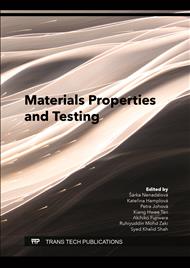[1]
Aricò, A.S.; Bruce, P.; Scrosati, B.; Tarascon, J.M.; Van Schalkwijk, W. Nanostructured materials for advanced energy conversion and storage devices. Nat. Mater. 2005, 4, 366–377.
DOI: 10.1038/nmat1368
Google Scholar
[2]
Yang, Z.; Ren, J.; Zhang, Z.; Chen, X.; Guan, G.; Qiu, L.; Zhang, Y.; Peng, H. Recent Advancement of Nanostructured Carbon for Energy Applications. Chem. Rev. 2015, 115, 5159–5223.
DOI: 10.1021/cr5006217
Google Scholar
[3]
Lee, J.; Mahendra, S.; Alvarez, P.J.J. Nanomaterials in the construction industry: A review of their applications and environmental health and safety considerations. ACS Nano 2010, 4, 3580–3590.
DOI: 10.1021/nn100866w
Google Scholar
[4]
Wang, X.; Feng, J.; Bai, Y.; Zhang, Q.; Yin, Y. Synthesis, Properties, and Applications of Hollow Micro-/Nanostructures. Chem. Rev. 2016, 116, 10983–11060,.
DOI: 10.1021/acs.chemrev.5b00731
Google Scholar
[5]
Ding, Y.; Zhou, P.; Han, T.; Liu, J. Environmentally Friendly and Cost-Effective Synthesis of Carbonaceous Particles for Preparing Hollow SnO2 Nanospheres and their Bifunctional Li-Storage and Gas-Sensing Properties. Crystals 2020, 10, 231,.
DOI: 10.3390/cryst10030231
Google Scholar
[6]
Papis, E.; Rossi, F.; Raspanti, M.; Dalle-Donne, I.; Colombo, G.; Milzani, A.; Bernardini, G.; Gornati, R. Engineered cobalt oxide nanoparticles readily enter cells. Toxicol. Lett. 2009, 189, 253–259,.
DOI: 10.1016/j.toxlet.2009.06.851
Google Scholar
[7]
Hu, S.; Melton, C.; Mukherjee, D. A facile route for the synthesis of nanostructured oxides and hydroxides of cobalt using laser ablation synthesis in solution (LASIS). Phys. Chem. Chem. Phys. 2014, 16, 24034–24044,.
DOI: 10.1039/c4cp03018d
Google Scholar
[8]
Amendola, V.; Meneghetti, M. What controls the composition and the structure of nanomaterials generated by laser ablation in liquid solution? Phys. Chem. Chem. Phys. 2013, 15, 3027–3046.
DOI: 10.1039/c2cp42895d
Google Scholar
[9]
Tsuji, T.; Hamagami, T.; Kawamura, T.; Yamaki, J.; Tsuji, M. Laser ablation of cobalt and cobalt oxides in liquids: Influence of solvent on composition of prepared nanoparticles. Appl. Surf. Sci. 2005, 243, 214–219,.
DOI: 10.1016/j.apsusc.2004.09.065
Google Scholar
[10]
Alheshibri, M.; Akhtar, S.; Al Baroot, A.; Elsayed, K.; Al Qahtani, H.S.; Drmosh, Q.A. Template-free single-step preparation of hollow CoO nanospheres using pulsed laser ablation in liquid enviromen. Arab. J. Chem. 2021, 14, 103317,.
DOI: 10.1016/j.arabjc.2021.103317
Google Scholar
[11]
Rawat, R.; Tiwari, A.; Arun, N.; Rao, S.V.S.N.; Pathak, A.P.; Rao, S.V.; Tripathi, A. Synthesis of CuO hollow nanoparticles using laser ablation: effect of fluence and solvents. Appl. Phys. A 2020, 126, 226,.
DOI: 10.1007/s00339-020-3403-1
Google Scholar
[12]
Mangababu, A.; Sarang Dev, G.; Chandu, B.; Bharati, M.S.S.; Venugopal Rao, S.; Nageswara Rao, S.V.S. Structural investigations of picosecond laser ablated GaAs nanoparticles in different liquids. Nano-Structures and Nano-Objects 2020, 23, 100509,.
DOI: 10.1016/j.nanoso.2020.100509
Google Scholar
[13]
Mintcheva, N.; Aljulaih, A.; Wunderlich, W.; Kulinich, S.; Iwamori, S. Laser-Ablated ZnO Nanoparticles and Their Photocatalytic Activity toward Organic Pollutants. Materials (Basel). 2018, 11, 1127,.
DOI: 10.3390/ma11071127
Google Scholar
[14]
Elsayed, K.A.; Imam, H.; Ahmed, M.A.; Ramadan, R. Effect of focusing conditions and laser parameters on the fabrication of gold nanoparticles via laser ablation in liquid. Opt. Laser Technol. 2013, 45, 495–502,.
DOI: 10.1016/j.optlastec.2012.06.004
Google Scholar
[15]
Athar, T.; Hakeem, A.; Topnani, N.; Hashmi, A. Wet Synthesis of Monodisperse Cobalt Oxide Nanoparticles. ISRN Mater. Sci. 2012, 2012, 1–5,.
DOI: 10.5402/2012/691032
Google Scholar
[16]
Xaba, T.; Mokgoera, L.; Nate, Z.; Shumbula, P.M.; Africa, S.; Division, A.M.; Africa, S. Synthesis and characterization of cubic structured cobalt oxide nanoparticles capped with topo through the decomposition of Bis( N-Cyclohexyl-1-Naphtaldeydato) Cobalt ( II ) complex as a single source precursor. Dig. J. Nanomater. Biostructures 2018, 13, 1141–1147.
Google Scholar
[17]
Gondal, M.A.; Drmosh, Q.A.; Yamani, Z.H.; Saleh, T.A. Synthesis of ZnO 2 nanoparticles by laser ablation in liquid and their annealing transformation into ZnO nanoparticles. Appl. Surf. Sci. 2009, 256, 298–304,.
DOI: 10.1016/j.apsusc.2009.08.019
Google Scholar



